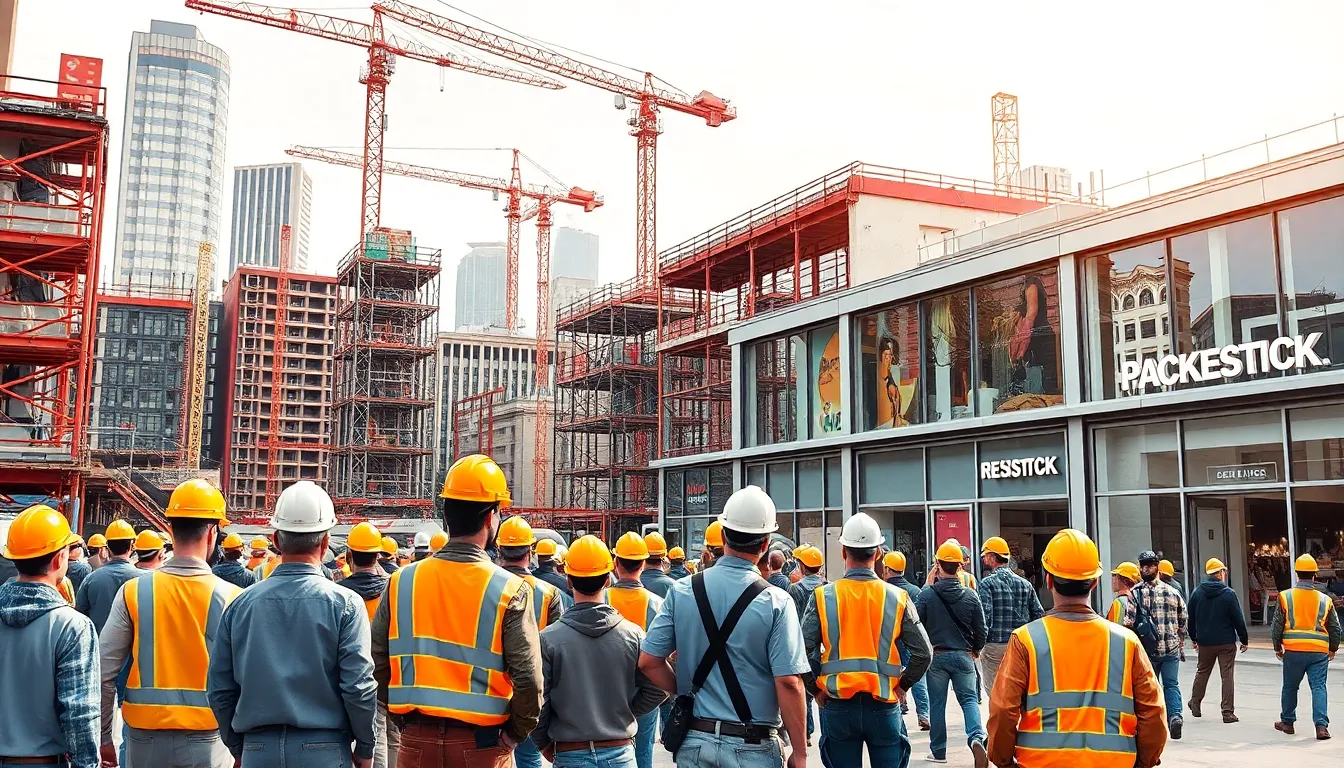Table of Contents
ToggleIn the bustling world of urban development, cities are like teenagers—constantly growing, sometimes awkward, and often in need of a little guidance. As concrete jungles expand and evolve, the impact of this growth ripples through communities, economies, and the environment. It’s not just about shiny skyscrapers and trendy coffee shops; the stakes are high, and the consequences can be as unpredictable as a cat on a hot tin roof.
Urban development shapes the way people live, work, and play. It can spark innovation or lead to chaos, depending on how it’s managed. With the right approach, cities can thrive and foster vibrant communities. But without careful planning, they might just end up as sprawling messes that leave residents feeling like they’re living in a game of Tetris gone wrong. Understanding the impact of urban development is crucial for anyone who wants to navigate the twists and turns of modern city life.
Overview of Urban Development Impact
Urban development significantly shapes communities, economies, and the environment. Communities often experience enhanced infrastructure and services from well-planned urban growth. Increased access to public transport, schools, and healthcare facilities contributes to improved quality of life. Economic growth tends to arise from new businesses and job opportunities associated with urban expansion.
However, negative consequences emerge from poorly managed development. Traffic congestion frequently intensifies as population density increases, leading to longer commute times. Environmental degradation can occur when natural resources are depleted or ecosystems disrupted, resulting in diminished biodiversity. Urban heat islands may develop due to extensive concrete and asphalt surfaces, raising local temperatures.
Socioeconomic disparities often manifest in rapidly developing areas. Wealthy neighborhoods may flourish, while marginalized communities lag in access to resources. Tensions can arise from gentrification, where rising property values displace long-term residents. Planners and stakeholders must engage with diverse community members to address these challenges.
Urban development impacts health and well-being, which requires careful consideration. Increased green spaces promote recreational activities, enhancing physical and mental health. Conversely, air and water pollution from industrial activities can lead to significant health issues.
Data-driven planning becomes essential for sustainable urban growth. Integrating technology, such as Geographic Information Systems (GIS), allows for better decision-making. Successful urban development relies on balancing economic growth with environmental sustainability and social equity. Understanding these dynamics aids cities in navigating contemporary development challenges effectively.
Economic Impacts of Urban Development

Urban development significantly influences local economies. It generates substantial changes in job markets and property values, ultimately shaping community livelihoods.
Job Creation
Urban development fosters job creation across various sectors. Construction projects create thousands of temporary jobs, contributing significantly to local employment figures. Additionally, the establishment of new businesses leads to permanent positions in retail, services, and technology sectors. For instance, a study shows that for every $1 million invested in development, approximately 15 jobs are created. Local communities benefit from increased economic activity, often leading to a decreased unemployment rate. Fresh opportunities enhance workforce skills through training and development initiatives, further bolstering community resilience.
Increased Property Values
Urban development typically results in increased property values. Improved infrastructure, such as roads and public transport systems, attracts homebuyers and investors. Data indicates that neighborhoods experiencing revitalization can see property values rise by 20% to 30%. Higher property values can elevate tax revenues for local governments, allowing for investments in public services. Gentrification processes may accompany this rise, often displacing lower-income residents. Although this phenomenon creates wealth for some, it complicates the socioeconomic landscape, necessitating careful planning to mitigate adverse effects on community demographics.
Social Impacts of Urban Development
Urban development significantly influences social dynamics within communities. Growth can enhance community cohesion by providing shared spaces and local amenities that foster interaction. Increased public parks, recreational facilities, and transit systems encourage residents to engage in social activities. Moreover, neighborhoods that prioritize walkability often report stronger community ties.
Displacement of residents frequently accompanies urban development, creating social fractures. Gentrification forces long-term residents out of their homes due to rising costs and changing neighborhood demographics. Approximately 20% to 30% of low-income families in rapidly developing areas experience displacement. Community networks often suffer as familiar faces leave, disrupting support systems essential for vulnerable populations. Without careful planning, both social cohesion and existing community fabric can deteriorate in the wake of urban transformation.
Environmental Impacts of Urban Development
Urban development significantly shapes the environment, influencing both biodiversity and human health. Examining urban growth reveals clear effects on ecosystems and urban green spaces.
Green Spaces and Sustainability
Developed areas often benefit from well-planned green spaces. Parks and gardens improve air quality and promote biodiversity, attracting various species. Sustainable urban design incorporates green features to enhance community well-being. Studies show that neighborhoods with ample green areas report up to 30% lower stress levels among residents. Ecological corridors allow wildlife movement, reducing habitat fragmentation. Integrating trees into urban landscapes can lower temperatures by 5 to 10 degrees Fahrenheit, offsetting urban heat effects. Addressing green space accessibility supports social equity within urban environments.
Pollution and Waste Management
Urban development creates significant challenges in pollution control and waste management. Industrial activities and vehicular emissions contribute to air pollution, leading to health risks such as respiratory diseases. Communities in areas with high pollution report increased healthcare needs. Strategies like implementing stricter zoning laws can help mitigate emissions. Waste management, including recycling initiatives, reduces landfill pressure and helps meet environmental standards. Cities that invest in efficient waste systems often see a 15% reduction in waste generation. Updating infrastructure to manage stormwater runoff prevents contamination of local waterways. Addressing these issues is essential for sustainable urban growth and overall public health.
Policy and Planning Considerations
Effective urban development requires careful consideration of policies and planning frameworks. Authorities must prioritize sustainable practices that promote economic growth while protecting community integrity. Data-driven approaches play a crucial role in this process, allowing for informed decisions that balance various interests.
Land use policies directly impact urban growth and can either encourage development or hinder progress. Zoning regulations must adapt to changing needs, promoting mixed-use spaces that foster economic diversity. Addressing affordable housing remains critical in mitigating the adverse effects of gentrification.
Collaboration among stakeholders enhances the planning process. Governments, developers, and community organizations must engage in dialogue to create inclusive development plans. Regular public forums can facilitate feedback and ensure that all voices are heard.
Environmental considerations must also inform planning decisions. Incorporating green spaces is vital for improving residents’ quality of life, as studies show parks and gardens significantly enhance community well-being. Efficient waste management systems are essential to minimize pollution and protect public health.
Transportation planning is another key area of focus. Investments in public transit systems can reduce traffic congestion and provide residents with better access to jobs and resources. Ensuring walkability in neighborhoods encourages social interaction and strengthens community ties.
Monitoring and evaluating development outcomes are necessary for long-term success. Regular assessments of socio-economic impacts help identify areas needing improvement and allow for timely adjustments. Strategic planning enhances urban resilience, equipping cities to handle future challenges while fostering equitable growth.
Urban development is a complex and multifaceted process that shapes the future of cities. It holds the potential to create vibrant communities while also posing significant challenges. The balance between economic growth and social equity is crucial for sustainable urban transformation. With thoughtful planning and collaboration among stakeholders, cities can thrive without sacrificing the well-being of their residents or the environment. As urban areas continue to evolve, prioritizing inclusivity and sustainability will be essential for fostering resilient communities that benefit everyone.








